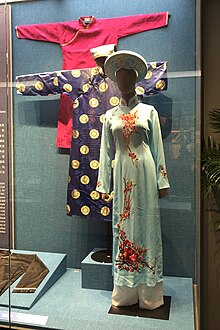
Back ཅིང་མི། BO Ĝingoj EO Gin (etnia) Spanish Jingit Finnish Jing (ethnie) French Kîn-chhu̍k HAK Suku Gin ID ジン族 Japanese 징족 Korean Gin (volk) Dutch
京族 Người Kinh (𠊛京) | |
|---|---|
 | |
| Total population | |
| 33,112 (2020 census)[1] | |
| Regions with significant populations | |
| China (Wutou, Wanwei and Shanxin islands off the coast of Dongxing, Guangxi) | |
| Languages | |
| Standard Chinese (lingua franca), Yue Chinese, Vietnamese (writing in chữ Nôm and chữ Hán) & other Vietic languages | |
| Religion | |
| Vietnamese folk religion · Mahayana Buddhism · Taoism · Roman Catholicism | |
| Related ethnic groups | |
| Vietnamese people, Muong, Chứt, Thổ |
| Gin people | |||||||||||||||||||||||
|---|---|---|---|---|---|---|---|---|---|---|---|---|---|---|---|---|---|---|---|---|---|---|---|
| Chinese name | |||||||||||||||||||||||
| Chinese | 京族 | ||||||||||||||||||||||
| |||||||||||||||||||||||
| Vietnamese name | |||||||||||||||||||||||
| Vietnamese alphabet | Dân tộc Kinh Người Kinh tại Trung Quốc | ||||||||||||||||||||||
| Chữ Hán | 民族京 | ||||||||||||||||||||||
| Chữ Nôm | 𠊛京在中國 | ||||||||||||||||||||||
The Gin,[2] or Jing people,[3] (Chinese: 京族, Sino-Vietnamese: Kinh tộc; Vietnamese: người Kinh tại Trung Quốc) are a community of descendants of ethnic Vietnamese people living in China. They mainly live in an area called the Jing Islands (京族三岛), off the coast of Dongxing, Fangchenggang, in the Chinese autonomous region of Guangxi. These territories were administered by the Nguyễn dynasty but were later ceded by the French to the Qing dynasty due to the 1887 convention, after the Sino-French war.
The Việt were labelled Yue (Chinese: 越族; pinyin: Yuèzú, Sino-Vietnamese: Việt tộc; Vietnamese: người Việt tại Trung Quốc) before the introduction of the names "Kinh", "Gin", or "Jing", in 1958.[4]
The Gin population was 33,112 as of 2020.[1] This number does not include the 36,205 Vietnamese nationals studying or working in Mainland China, recorded by the 2010 national population census.[5]
- ^ a b "2–22. Population by ethnic groups and gender". National Bureau of Statistics of China. Retrieved 10 December 2021.
- ^ "Names of nationalities of China in romanization with codes". 中国民族报. Archived from the original on 1 November 2009.
- ^ James Stuart Olson (28 February 1998). An Ethnohistorical Dictionary of China. Greenwood Press. p. 158. ISBN 978-0313288531.
- ^ "京 族". Communist Party of China. Archived from the original on 2020-10-03. Retrieved 2020-09-10.
- ^ "Major Figures on Residents from Hong Kong, Macao and Taiwan and Foreigners Covered by 2010 Population Census". National Bureau of Statistics of China. April 29, 2011. Archived from the original on May 14, 2011. Retrieved May 4, 2011.